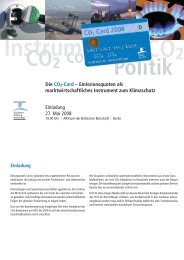Impulses for Growth and Employment through Profitable Savings in ...
Impulses for Growth and Employment through Profitable Savings in ...
Impulses for Growth and Employment through Profitable Savings in ...
Create successful ePaper yourself
Turn your PDF publications into a flip-book with our unique Google optimized e-Paper software.
sults are on h<strong>and</strong> with respect to appraisals<br />
of the national economic effects of<br />
programmes designed to <strong>in</strong>crease energy<br />
efficiency 7 .<br />
Appraisals of <strong>Profitable</strong> Productivity<br />
Increases <strong>in</strong> S<strong>in</strong>gle-Companies<br />
Material sav<strong>in</strong>gs can be <strong>in</strong>terpreted as a<br />
k<strong>in</strong>d of cost reduction that leads to <strong>in</strong>creased<br />
productivity. A dematerialization<br />
of the economy has similar effects on employment<br />
as productivity <strong>in</strong>creases. An<br />
<strong>in</strong>crease <strong>in</strong> productivity 8 <strong>in</strong> turn is led primarily<br />
by product <strong>and</strong> process <strong>in</strong>novation.<br />
An abundance of empirical literature is<br />
available on this topic 9 . There are three<br />
ma<strong>in</strong> conclusions.<br />
• Many analyses 10 <strong>for</strong> Germany come to<br />
the conclusion that process <strong>in</strong>novation<br />
leads to employment losses. While<br />
7 Cf. <strong>for</strong> example Bach, S. <strong>and</strong> C. Bork, M. Kohlhaas,<br />
C. Lutz, B. Meyer, B. Preatorius, H. Welsch,<br />
Die ökologische Steuerre<strong>for</strong>m <strong>in</strong> Deutschl<strong>and</strong>. E<strong>in</strong>e<br />
modellgestützte Analyse ihrer Wirkungen auf Wirtschaft<br />
und Umwelt, Berl<strong>in</strong> 2001; Barker, T., Achiev<strong>in</strong>g<br />
a 10 per cent cut <strong>in</strong> Europe’s CO2 emissions<br />
us<strong>in</strong>g aditional excise duties: multilateral versus<br />
unilateral action E3ME, E3ME Work<strong>in</strong>g Paper No.<br />
29, Vienna 1998; Böhr<strong>in</strong>ger, C., <strong>and</strong> H. Welsch, A.<br />
Löschel, Environmental Taxation <strong>and</strong> Structural<br />
Change <strong>in</strong> an Open Economy – A CGE Analysis<br />
with Imperfect Competition <strong>and</strong> Free Entry, ZEW<br />
Discussion Paper No. 01-07, Mannheim2001;<br />
RWI/Ifo (eds.), Gesamtwirtschaftliche Beurteilung<br />
von CO2-M<strong>in</strong>derungsstrategien, Untersuchungen<br />
des Rhe<strong>in</strong>isch-Westfälischen Instituts für Wirtschafts<strong>for</strong>schung,<br />
Issue 19, Essen 1996.<br />
8 The OECD provides a good overview <strong>in</strong>: Organisation<br />
<strong>for</strong> Economic Co-operation <strong>and</strong> Development<br />
(OECD) (ed.), The Sources of Economic <strong>Growth</strong> <strong>in</strong><br />
OECD Countries, Paris 2003.<br />
9 For a broad overview see: Lehner, F. <strong>and</strong> M.<br />
Baethge, J. Kühl, F. Stille (eds.), Beschäftigung<br />
durch Innovation, Munich 1998. Or <strong>for</strong> a shorter<br />
compilation see: Beeker, D., Technischer Fortschritt<br />
und Beschäftigung, Institut der deutschen Wirtschaft<br />
Köln, Beiträge zur Wirtschafts- und Sozialpolitik, No.<br />
264, Cologne 2001.<br />
10 Rottmann, H. <strong>and</strong> M. Rusch<strong>in</strong>ski, The Labour<br />
Dem<strong>and</strong> <strong>and</strong> the Innovation Behaviour of Firms,<br />
Jahrbücher für Nationalökonomie und Statistik,<br />
Volume 217 (1998), pp. 741-752; or: Blech<strong>in</strong>ger, D.<br />
<strong>and</strong> F. Pfeiffer, Qualifikation, Beschäftigung und<br />
technischer Fortschritt, Jahrbücher für Nationalökonomie<br />
und Statistik, Volume 218 (1999), pp. 128-<br />
146; also: Flaig, G. <strong>and</strong> H. Rottmann, Faktorpreise,<br />
technischer Fortschritt und Beschäftigung, E<strong>in</strong>e<br />
empirische Analyse für das westdeutsche verarbeitende<br />
Gewerbe, ifo-Diskussionsbeitrag No. 59,<br />
Munich 1998.<br />
Bellmann/Kohaut 11 do not come to<br />
clear conclusions, other studies 12 show<br />
a positive correlation. A more detailed<br />
comparison of analyses shows that a<br />
positive <strong>in</strong>fluence of process <strong>in</strong>novations<br />
on employment is more likely to<br />
occur if many secondary compensatory<br />
effects (price reductions, quality<br />
improvements, <strong>in</strong>vestment growth,<br />
wage reductions etc.) are considered.<br />
This is a very plausible f<strong>in</strong>d<strong>in</strong>g. On the<br />
s<strong>in</strong>gle-company level rationalisation<br />
measures lead to employment losses,<br />
at least <strong>in</strong> the short term. Viewed from<br />
a national economic <strong>and</strong> medium term<br />
perspective a different picture emerges<br />
because released personnel can aga<strong>in</strong><br />
f<strong>in</strong>d productive employment.<br />
• The situation with respect to product<br />
<strong>in</strong>novation is different. Here, most<br />
studies show a positive correlation between<br />
<strong>in</strong>novation, i.e. productivity <strong>in</strong>creases,<br />
<strong>and</strong> employment.<br />
The INFORGE Model<br />
The national economic effects of dematerialization<br />
are so complex that they can<br />
only be mean<strong>in</strong>gfully captured <strong>and</strong> empirically<br />
measured us<strong>in</strong>g a model. For that<br />
purpose the INFORGE (INter<strong>in</strong>dustry<br />
FORcast<strong>in</strong>g GErmany) model is used.<br />
INFORGE is a profoundly structured sectoral<br />
<strong>for</strong>ecast<strong>in</strong>g <strong>and</strong> simulation model that<br />
has been updated annually s<strong>in</strong>ce 1996<br />
<strong>and</strong> used <strong>in</strong> many applications 13 . The ver-<br />
11 Bellmann, L. <strong>and</strong> S. Kohaut, Betriebliche Beschäftigungsentwicklung<br />
und Innovationsaktivitäten, <strong>in</strong>:<br />
Mitteilungen IAB, Volume 32 (1999), pp. 416-422.<br />
12 Almus, M. <strong>and</strong> E. Nehrl<strong>in</strong>ger, Beschäftigungsdynamik<br />
<strong>in</strong> jungen <strong>in</strong>novativen Unternehmen: Empirische<br />
Ergebnisse für West-Deutschl<strong>and</strong>, Diskussionspapier<br />
No. 98-09, Zentrum für Europäische<br />
Wirtschafts<strong>for</strong>schung, Mannheim 1998; or Smolny,<br />
W. <strong>and</strong> T. Schneeweis, Innovation, Wachstum und<br />
Beschäftigung, E<strong>in</strong>e empirische Untersuchung auf<br />
der Basis des ifo-Unternehmenspanels Center <strong>for</strong><br />
International Labour Economics, Forschungsschwerpunkt<br />
„Internationale Arbeitsmarkt<strong>for</strong>schung“,<br />
Fakultät für Wirtschaftswissenschaften und Statistik,<br />
Discussion Paper 33-1996, Konstanz.<br />
13 Cf. <strong>for</strong> example: Lichtblau, K. <strong>and</strong> B. Meyer, G.<br />
Ewerhart, Komplementäres Beziehungsgeflecht<br />
zwischen Industrie und Dienstleistungen, <strong>in</strong>: iwtrends,<br />
4/96, pp. 1-24; or: Elixmann, D. <strong>and</strong> A. Keuter,<br />
B. Meyer, Sectoral <strong>Employment</strong> Effects of the<br />
Evolution of the German Telecommunications Mar-<br />
4




